Frank Borek digs way in the back of his gun safe a pulls out a Daewoo DR200 Rifle that you may grow to like.
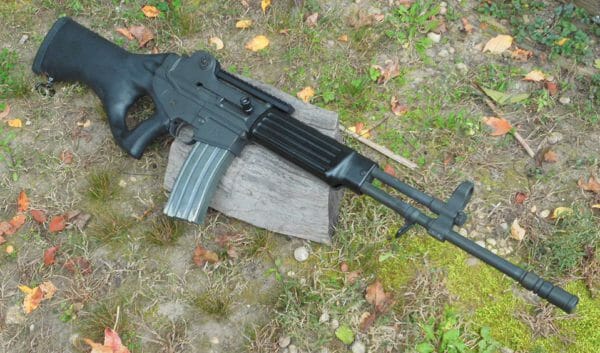
U.S.A. -(AmmoLand.com)- With the firearms world still in a state of flux, there remains one constant: that retro is still in. Guns that have been forgotten even when they were new have become collector’s items bringing high prices in stores and at auction. Even rifles that were imported during the inane Assault Weapons Ban have seen a rise in prices. More and more want to float away from the sea of ARs and wind up in a sea of neon from the ’80s. If that means buying a rifle with an idiotic thumbhole stock and no muzzle device, then so be it. That’s how many are winding up at port of the Daewoo DR-200.
Daewoo DR200 Rifle
Known for their brutal efficiency, the South Korean soldiers deployed to the Vietnam War were sent as a show of anti-communist solidarity, and so that ROK soldiers would gain valuable combat experience. When they were first deployed, the ROK soldiers and Marines went with the venerable M1 Garand and M1 Carbine that had served them well during the Korean War. But as time passed, they began to eventually replace them with American M16 rifles, teaching them the value of lightweight rifles firing smaller, high-velocity bullets.
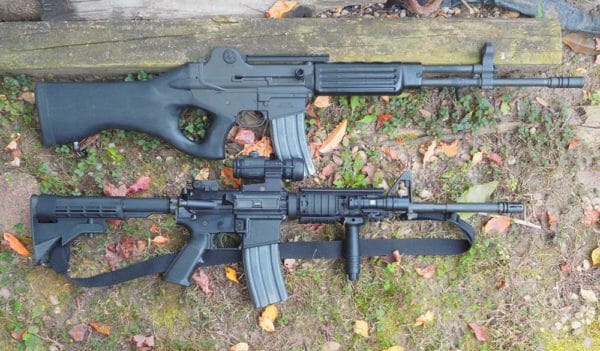
The ROK began production of the M16A1 after receiving a license from Colt, though the arrangement wasn’t perfect as it was believed that the price was too high for the number of rifles needed. The ROK government also felt a bit of national pride and wished to become more self-reliant in the defense sector and begin manufacturing their own weapons. Modifying a variety of M16 rifles, the decision was made to adopt a rifle that was a marriage of M16 features and a long-stroke gas piston. This became the Daewoo K2 rifle. The long-stroke gas piston was chosen both for reliability and perceived ease of maintenance, an important factor when dealing with a military formed mostly of conscripts.
The fact that it used 5.56mm ammunition and fed from M16 magazines was a sign of the close ties with the US military and the possibility of having to draw from US supplies if needed.
In the 1980s, Daewoo Ltd. began exporting their firearms to the USA to cash in on what was perceived as a lucrative market. But while many today look back at the era as something as a halcyon era of firearms, the reality was a bit different. Violence was rising, and the national mood was crumbling, described by President Jimmy Carter as a “national malaise”. There was a burgeoning survivalist movement, seen and shunned by many as nothing more than a bunch of crazies hiding in the woods. Thanks to some well-publicized and sensationalized shootings and murders, such evil-looking firearms such as the Daewoo K1 rifle were seen as “extremist anti-government militia arms”.
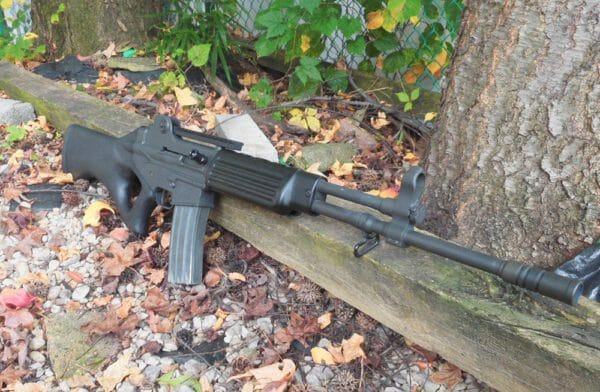
Many gun owners were more than willing to throw their own kind under the bus to protect their hunting rifle and labeled themselves “sportsmen” and “conservationists” who were more interested in the great outdoors than the guns themselves. This all culminated in the 1989 Import Ban which banned the import of firearms that lacked certain “sporting” features and required to either be neutered for import or have a certain number of domestically made parts installed. This would eventually be followed by the infamous 1994 Assault Weapons Ban, which is how we wound up with the Daewoo K1 turning into the DR200.
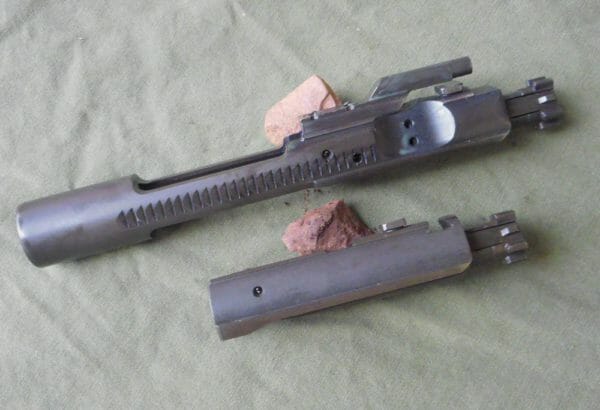
The lineage of the M16 is present in both the handling and internals of the DR200. Disassembly is straightforward, there is a latch at the rear of the upper receiver, make sure the small toggle on the latch is up and push it forward. The upper hinges open like an AR, and there is a captive pin upfront if you wish to separate the upper and lower. Pull out the recoil spring, and pull the gas piston to the rear. When the charging handle is at the rearmost position, pull it out and now you can remove the piston and bolt. Look familiar?
The DR200’s bolt-carrier should. Since it features a multi-lugged bolt just like the AR, but they aren’t interchangeable. The trigger group however is interchangeable with AR trigger groups, an important feature as it makes changing it out to something better far easier. Sadly the flash hider is simply a fake that is not only soldered (or pinned & welded) in place but lacks the cutouts of an actual flash hider or muzzle brake. On top of the upper is a Stormwerkz optics rail that had been installed by a previous owner.
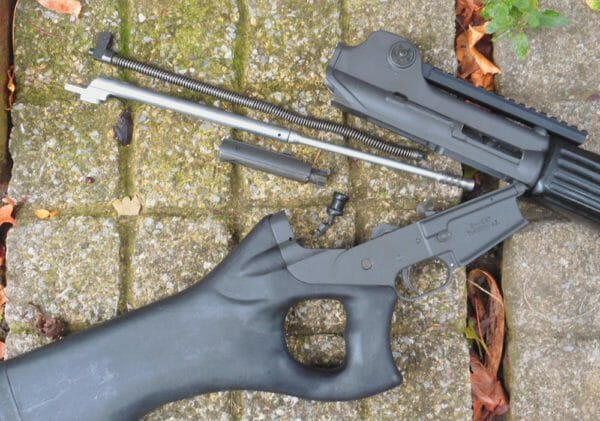
How does the rifle handle? Well, it most likely would handle a lot better if it wasn’t for that damnable thumbhole stock!?
First the good, the trigger isn’t great like any stock AR trigger. However, it is serviceable for those who decide to bear with it. The rear sight is adjustable for windage with an A1 rear sight adjustment dial. Unlike regular A1 sights, it is also elevation adjustable with a dial on the opposite side, but there is only one aperture to choose from. The charging handle knob is easy to grasp, the magazine release button is in the same place as the AR, as is the bolt release button. As for the bad, the thumbhole stock adds quite a bit of length to the length of pull, meaning those with smaller arms might have a bit of trouble with handling the rifle.
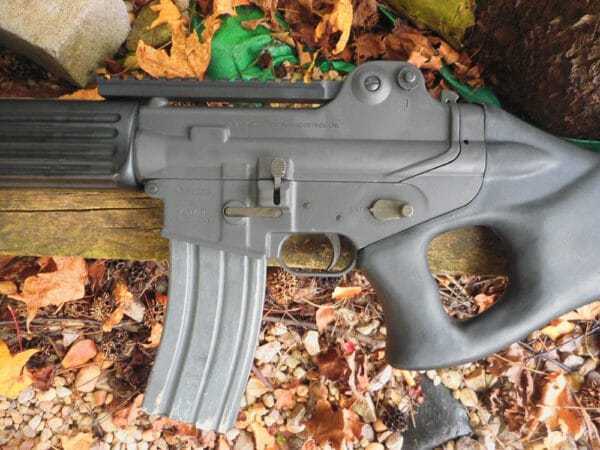
The safety is also a bear, as though it is located in the same place as an AR safety, the thumbhole stock makes it difficult to properly hit. In addition, the switch must be rotated a full 180 degrees to disengage or engage. The weight of the rifle makes it a bit smoother to shoot than what you might expect from a service rifle clone. At 50 yards, I brought in groups of around 2 inches using steel-cased Red Army Standard ammunition, as that is what I had on hand.
To sum it up the Daewoo DR200 Rifle is much like Orson Krennic remarking to Galen Erso at the beginning of Rogue One: “We were on the verge of greatness. We were this close!”. The foundations of something great is here with the DR200. However all of the features to neuter a great service rifle into an inoffensive “sporting arm” have also neutered its handling as well. I did not acquire this rifle with plans to keep it in this condition, however. Like many, I have purchased this rifle to return it back into a service rifle, though I intend to preserve its older appearance.
About Frank Borek:
Frank Borek is a former US Navy sailor and graduate of Delaware Valley College whose love of firearms comes from his love of historical minutiae and Soldier of Fortune magazine. You can usually find him at gun shops and gun shows digging through racks, tables, and bins of old guns and gear covered in dust and grease.

